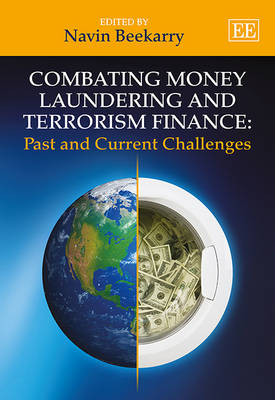
Combating Money Laundering and Terrorism Finance: Past and Current Challenges
Edward Elgar Publishing Ltd (Verlag)
978-1-84980-751-7 (ISBN)
Edited by Navin Beekarry, International Anti-Money Laundering, Corruption and Asset Recovery Expert and Doctor of Juridical Science Candidate, International Finance, George Washington University School of Law, US
Contents:
Acknowledgements
Introduction Navin Beekarry
PART I RISK-BASED APPROACH TO COMBATING MONEY LAUNDERING / TERRORISM FINANCING
1. Lucia Dalla Pellegrina and Donato Masciandaro (2009), ‘The Risk-Based Approach in the New European Anti-Money Laundering Legislation: A Law and Economics View’
2. David Chaikin (2009), ‘Risk-Based Approaches to Combating Financial Crime’
3. Andrew Proctor (2005), ‘Supporting a Risk-Based Anti-Money Laundering Approach Through Enforcement Action’
4. Dionysios S. Demetis and Ian O. Angell (2007), ‘The Risk-Based Approach to AML: Representation, Paradox, and the 3rd Directive’
5. Louis de Koker (2009), ‘Identifying and Managing Low Money Laundering Risk: Perspectives on FATF’s Risk-Based Guidance’
PART II THE AML / CFT INTERNATIONAL STANDARDS: COMPLIANCE ISSUES
6. Navin Beekarry (2011), ‘The International Anti-Money Laundering and Combating the Financing of Terrorism Regulatory Strategy: A Critical Analysis of Compliance Determinants in International Law’
7. Andrew Haynes (2009), ‘Money Laundering: From Failure to Absurdity’
8. Jackie Johnson (2008), ‘Third Round FATF Mutual Evaluations Indicate Declining Compliance’
9. Robin Sykes (2007), ‘Some Questions on the FATF 40+9 and the Methodology for Assessing Compliance with the FATF 40+9 Recommendations’
10. Jackie Harvey (2008), ‘Just How Effective is Money Laundering Legislation?’
11. J.C. Sharman (2009), ‘The Bark is the Bite: International Organizations and Blacklisting’
12. Joras Ferwerda (2009), ‘The Economics of Crime and Money Laundering: Does Anti-Money Laundering Policy Reduce Crime?’
13. Richard K. Gordon (2011), ‘Losing the War Against Dirty Money: Rethinking Global Standards on Preventing Money Laundering and Terrorism Financing’
PART III THE INTERNATIONAL ANTI-MONEY LAUNDERING AND COMBATING TERRORISM FINANCING REGULATION
14. Eleni Tsingou (2005), ‘Global Governance and Transnational Financial Crime: Opportunities and Tensions in the Global Anti-Money Laundering Regime’
15. Rainer Hülsse and Dieter Kerwer (2007), ‘Global Standards in Action: Insights from Anti-Money Laundering Regulation’
16. Barry A.K. Rider (2003), ‘Financial Regulation and Supervision after 11th September, 2001’
17. John Christensen (2007), ‘The Long and Winding Road: Tackling Capital Flight and Tax Evasion’
18. J.C. Sharman (2008), ‘Power and Discourse in Policy Diffusion: Anti-Money Laundering in Developing States’
19. Mónica Serrano and Paul Kenny (2003), ‘The International Regulation of Money Laundering’
PART IV THE ECONOMICS OF MONEY LAUNDERING
20. Peter J. Quirk (1997), ‘Macroeconomic Implications of Money Laundering’
21. Donato Masciandaro (1999), ‘Money Laundering: the Economics of Regulation’
22. Peter Reuter and Edwin M. Truman (2004), ‘How Much Money is Laundered?’
23. John Walker and Brigitte Unger (2009), ‘Measuring Global Money Laundering: “The Walker Gravity Model”’
24. Jim Thomas (1999), ‘Quantifying the Black Economy: ‘Measurement Without Theory’ Yet Again?’
25. Richard K. Gordon (1999), ‘Anti-Money-Laundering Policies: Selected Legal, Political, and Economic Issues’
PART V THE INTEGRATION OF COMBATING TERRORISM AND ANTI-MONEY LAUNDERING
26. Bruce Zagaris (2002), ‘The Merging of the Counter-Terrorism and Anti-Money Laundering Regimes’
27. Matthew Levitt (2003), ‘Stemming the Flow of Terrorist Financing: Practical and Conceptual Challenges’
28. Ilias Bantekas (2003), ‘The International Law of Terrorist Financing’
29. Richard Barrett (2009), ‘Time to Reexamine Regulation Designed to Counter the Financing of Terrorism’
30. Michael Levi (2010), ‘Combating the Financing of Terrorism: A History and Assessment of the Control of ‘Threat Finance’’
PART VI SECTORAL ISSUES IN ANTI-MONEY LAUNDERING AND COMBATING TERRORISM FINANCING
31. Benton E. Gup and Navin Beekarry (2009), ‘Limited Liability Companies (LLCs) and Financial Crimes’
32. J.C. Sharman and David Chaikin (2009), ‘Corruption and Anti-Money-Laundering Systems: Putting a Luxury Good to Work’
33. David J. Middleton and Michael Levi (2005), ‘The Role of Solicitors in Facilitating ‘Organized Crime’: Situational Crime Opportunities and their Regulation’
34. Ross S. Delston and Stephen C. Walls (2009), ‘Reaching Beyond Banks: How to Target Trade-Based Money Laundering and Terrorist Financing Outside the Financial Sector’
35. Samuel McSkimming (2010), ‘Trade-Based Money Laundering: Responding to an Emerging Threat’
36. Peter Reuter and Edwin M. Truman (2004), ‘Money Laundering: Methods and Markets’
| Erscheint lt. Verlag | 29.3.2013 |
|---|---|
| Reihe/Serie | Elgar Mini Series |
| Verlagsort | Cheltenham |
| Sprache | englisch |
| Maße | 169 x 244 mm |
| Themenwelt | Recht / Steuern ► EU / Internationales Recht |
| Recht / Steuern ► Strafrecht ► Besonderes Strafrecht | |
| ISBN-10 | 1-84980-751-5 / 1849807515 |
| ISBN-13 | 978-1-84980-751-7 / 9781849807517 |
| Zustand | Neuware |
| Haben Sie eine Frage zum Produkt? |
aus dem Bereich


